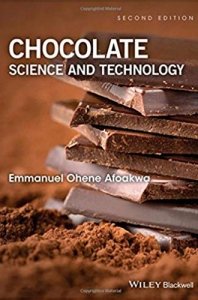Ref: CT008
EUR 170,-
excl. VAT + postage
Chocolate Science and Technology, 2nd Edition
by Emmanuel Ohene Afoakwa
John Wiley & Sons Ltd
Publication date: 2016
Hardcover, 507 pages
ISBN: 978-1-1189-1378-9
This second edition provides information on recent advances in the science and technology of chocolate manufacture and the entire international cocoa industry. It provides detailed review on a wide range of topics including cocoa production, cocoa and chocolate manufacturing operations, sensory perception of chocolate quality, flavour release and perception, sugar replacement and alternative sweetening solutions in chocolate production, industrial manufacture of sugar-free chocolates as well as the nutrition and health benefits of cocoa and chocolate consumption.
The topics cover modern cocoa cultivation and production practices with special attention on cocoa bean composition, genotypic variations in the bean, post-harvest pre-treatments, fermentation and drying processes, and the biochemical basis of these operations. The scientific principles behind industrial chocolate manufacture are outlined with detailed explanations of the various stages of chocolate manufacturing including mixing, refining, conching and tempering. Other topics covered include the chemistry of flavour formation and development during cocoa processing and chocolate manufacture; volatile flavour compounds and their characteristics and identification; sensory descriptions and character; and flavour release and perception in chocolate. The nutritional and health benefits of cocoa and chocolate consumption as well as the application of HACCP and other food safety management systems such as ISO 22,000 in the chocolate processing industry are also addressed. Additionally, detailed research on the influence of different raw materials and processing operations on the flavour and other quality characteristics of chocolates have been provided with scope for process optimization and improvement.
The book is intended to be a desk reference for all those engaged in the business of making and using chocolate worldwide; confectionery and chocolate scientists in industry and academia; students and practising food scientists and technologists; nutritionists and other health professionals; and libraries of institutions where agriculture, food science and nutrition is studied and researched.
Table of Contents
1 History, origin and taxonomy of cocoa
2 World cocoa production, processing and chocolate consumption pattern, 17
2.1 Introduction
2.2 World production of cocoa
2.3 Major changes in world cocoa trade
2.4 Cocoa yield in producing countries
2.5 World cocoa grindings trends between 2005–2006 and 2014–2015
2.6 World stocks of cocoa beans
2.7 International cocoa price developments
2.8 Cocoa processing trends
2.9 Cocoa and chocolate consumption
2.10 Fairtrade cocoa and chocolate in the modern confectionery industry
2.11 The organic cocoa in chocolate confectionery industry
2.12 The changing chocolate market
3 Traditional and modern cocoa cultivation practices, 49
3.1 Introduction
3.2 Environmental requirements for cocoa cultivation (Temperature, Rainfall, Soils and nutrition)
3.3 Traditional cocoa cultivation practices
3.4 Modern cocoa cultivation practices using vegetative propagation
3.5 Establishment and shade
3.6 Flowering and pod development
3.7 Harvesting of cocoa pods
3.8 Pod breaking
3.9 The cocoa pod
3.10 Good agricultural practices in cocoa cultivation
4 Cocoa diseases and pests and their effects on chocolate quality, 73
4.1 Introduction
4.2 Major cocoa diseases
4.3 Cocoa pests
4.4 Cocoa crop protection
5 Cocoa bean composition and chocolate flavour development, 80
5.1 Introduction
5.2 Bean composition and flavour precursor formation
5.3 Effects of genotype on cocoa bean flavour
5.4 Flavour development during post-harvest treatments of cocoa
5.5 Conclusion
6 Cocoa processing technology, 102
6.1 Introduction
6.2 Bean selection and quality criteria
6.3 Cocoa quality, grading and storage
6.4 Selection of bean blends and chocolate flavour quality
6.5 Steps in cocoa processing (Cleaning, breaking and winnowing, Sterilization, Alkalization, Roasting, Nib grinding and liquor treatment, Liquor pressing, Cake grinding (kibbling), Cocoa powder production, Cocoa butter)
7 Industrial chocolate manufacture – processes and factors influencing quality, 117
7.1 Introduction
7.2 Chocolate manufacturing processes, (Mixing, Refining, Conching)
7.3 Tempering, lipid crystallization and continuous phase character during chocolate manufacture
7.4 Casting and moulding
7.5 Cooling
7.6 Demoulding
7.7 Wrapping/Packaging
7.8 Factors influencing rheological and textural qualities in chocolate
7.9 Chocolate quality and defects
7.10 Conclusion and further research,
8 The chemistry of flavour development during cocoa processing and chocolate manufacture, 154
8.1 Introduction
8.2 Influence of bean selection on chocolate flavour quality
8.3 Effect of roasting
8.4 Flavour development during chocolate manufacture
8.5 Key flavour compounds in milk chocolate
8.6 Key flavour compounds in dark chocolate
8.7 Conclusion
9 Alternative sweetening and bulking solutions in chocolate manufacture, 171
9.1 Introduction
9.2 Types of sugar substitutes and their characteristics
9.3 High-potency sweeteners
9.4 Bulk sweeteners
9.5 Low-digestible carbohydrate polymers
9.6 Laxation and low–digestible carbohydrate polymers
9.7 Applicability and suitability of different sweeteners and carbohydrate polymers in chocolate processing
9.8 Importance of blending different sugar substitutes
10 Sensory character and flavour perception of chocolates, 202
10.1 Summary and industrial relevance
10.2 Introduction
10.3 Sensory perception of quality in chocolates (Appearance, Texture, Taste, Flavour and aroma)
10.4 Sensory assessment of chocolates
10.5 Factor influencing chocolate flavour
10.6 Flavour release and perception of sweetness in chocolate
10.7 Dynamism of flavour perception in chocolate
10.8 Retronasal flavour release and perception during chocolate consumption
10.9 Measurement of flavour release and intensity in chocolates
10.10 Electronic noses and tongues as online sensors for sensory assessment of chocolates
10.11 Conclusion
11 Nutritional and health benefits of cocoa and chocolate consumption, 223
12 Processing effects on the rheological, textural and melting properties during chocolate manufacture, 236
12.1 Summary and industrial relevance
12.2 Introduction
12.3 Materials and methods
12.4 Results and discussion
12.5 Relationships between Casson model and ICA recommendations
12.6 Textural properties
12.7 Microstructural properties of molten dark chocolate
12.8 Melting properties of dark chocolate
12.9 Relationships between rheological, textural and melting properties of dark chocolate
12.10 Conclusion
13 Tempering behaviour during chocolate manufacture: Effects of varying product matrices, 297
13.1 Summary and industrial relevance
13.2 Introduction
13.3 Materials and methods
13.4 Results and discussion
13.5 Conclusion
14 Tempering and fat crystallization effects on chocolate quality, 317
15 Fat bloom formation and development in chocolates, 345
16 Matrix effects on flavour volatiles character and release in chocolates, 365
17 Process optimization and product quality characteristics during sugar-free chocolate manufacture, 382
18 Food safety management systems in chocolate processing, 399
19 Application of ISO 22000 and hazard analysis and critical control points (HACCP) in chocolate processing, 416
20 Conclusions and industrial applications, 441

